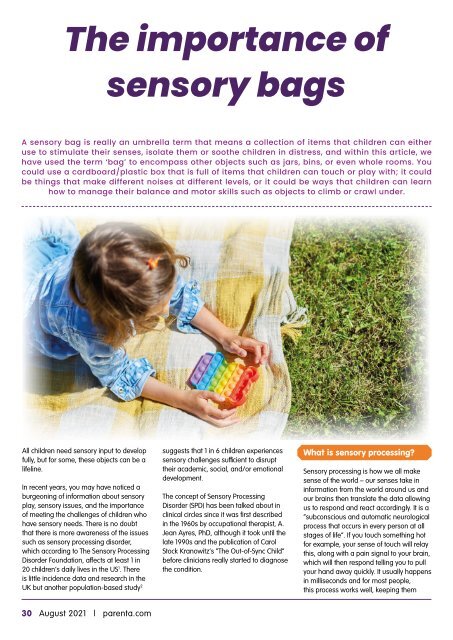August 2021 Parenta magazine
- No tags were found...
You also want an ePaper? Increase the reach of your titles
YUMPU automatically turns print PDFs into web optimized ePapers that Google loves.
The importance of<br />
sensory bags<br />
A sensory bag is really an umbrella term that means a collection of items that children can either<br />
use to stimulate their senses, isolate them or soothe children in distress, and within this article, we<br />
have used the term ‘bag’ to encompass other objects such as jars, bins, or even whole rooms. You<br />
could use a cardboard/plastic box that is full of items that children can touch or play with; it could<br />
be things that make different noises at different levels, or it could be ways that children can learn<br />
how to manage their balance and motor skills such as objects to climb or crawl under.<br />
All children need sensory input to develop<br />
fully, but for some, these objects can be a<br />
lifeline.<br />
In recent years, you may have noticed a<br />
burgeoning of information about sensory<br />
play, sensory issues, and the importance<br />
of meeting the challenges of children who<br />
have sensory needs. There is no doubt<br />
that there is more awareness of the issues<br />
such as sensory processing disorder,<br />
which according to The Sensory Processing<br />
Disorder Foundation, affects at least 1 in<br />
20 children’s daily lives in the US 1 . There<br />
is little incidence data and research in the<br />
UK but another population-based study 2<br />
suggests that 1 in 6 children experiences<br />
sensory challenges sufficient to disrupt<br />
their academic, social, and/or emotional<br />
development.<br />
The concept of Sensory Processing<br />
Disorder (SPD) has been talked about in<br />
clinical circles since it was first described<br />
in the 1960s by occupational therapist, A.<br />
Jean Ayres, PhD, although it took until the<br />
late 1990s and the publication of Carol<br />
Stock Kranowitz’s “The Out-of-Sync Child”<br />
before clinicians really started to diagnose<br />
the condition.<br />
What is sensory processing?<br />
Sensory processing is how we all make<br />
sense of the world – our senses take in<br />
information from the world around us and<br />
our brains then translate the data allowing<br />
us to respond and react accordingly. It is a<br />
“subconscious and automatic neurological<br />
process that occurs in every person at all<br />
stages of life”. If you touch something hot<br />
for example, your sense of touch will relay<br />
this, along with a pain signal to your brain,<br />
which will then respond telling you to pull<br />
your hand away quickly. It usually happens<br />
in milliseconds and for most people,<br />
this process works well, keeping them<br />
protected and feeding them the information<br />
they need to move on and process other<br />
more intellectual or conceptual ideas.<br />
Our eight senses are:<br />
• Visual (sight)<br />
• Auditory (sound)<br />
• Taste (gustatory)<br />
• Smell (olfactory)<br />
• Touch (somatosensory)<br />
• Proprioception (muscle and joint<br />
movement)<br />
• Vestibular (balance and head<br />
movement)<br />
• Interoception (our sense of basic<br />
primary functions like needing the toilet<br />
or feeling hungry<br />
People with sensory processing<br />
impairment/disorder, may have difficulty<br />
with one or more of these, and their<br />
sensory processing may not develop as<br />
efficiently as it should. The child can then<br />
develop behavioural and social difficulties<br />
that can affect many daily activities such as<br />
getting dressed or walking down a street,<br />
which can then affect their experiences<br />
at nursery, school, and their academic<br />
achievement.<br />
For sensory modulation disorders, children<br />
struggle to tolerate the level of sensory<br />
input that others do, so they may be<br />
oversensitive to some things, or actively<br />
seek out other sensory feelings to fulfil a<br />
sensory need. Many people who have<br />
normal sensory processing often find it<br />
hard to understand or empathise with<br />
people who have disorders, dismissing<br />
their distress as them being ‘fussy’ or<br />
unreasonable. However, most of us can<br />
understand the distress of hearing nails<br />
scraping down a blackboard, or having an<br />
itch that we just can’t scratch. Everything<br />
else seems to take second place, and if<br />
we wanted to focus on other things (like<br />
learning or schoolwork), we would have to<br />
either stop the input (i.e. the nails on the<br />
blackboard), or be soothed and satisfied<br />
(like the itch). Now imagine your world<br />
was full of things you either couldn’t stand<br />
or couldn’t be satiated by, and you will go<br />
some way to understanding the problems<br />
that children with sensory disorders face<br />
every day.<br />
This is where sensory bags, bottles, jars,<br />
and bins can help as they can provide<br />
stimulation or be soothing to the child.<br />
The important thing to remember here<br />
is that the individual needs of the child<br />
should always be taken into account<br />
and practitioners must have a good<br />
understanding of each child’s particular<br />
needs in order to meet them. That said,<br />
children with sensory needs may not<br />
have all received a full diagnosis or have<br />
a sensory activity profile/plan in nursery,<br />
so there is something to be said for<br />
experimenting and seeing what works best<br />
with each child.<br />
Remember that sensory stimulation is not<br />
just for the children with sensory disorders<br />
too. All children need sensory inputs from<br />
a variety of different items and they will<br />
need you, the practitioner, to help them<br />
understand them.<br />
Benefits of sensory bags<br />
Using sensory items, children can:<br />
• Build neural connections within the<br />
brain<br />
• Develop fine motor skills handling and<br />
manipulating objects<br />
• Learn social skills by sharing or playing<br />
• Be calmed and soothed<br />
• Fulfil sensory needs<br />
• Maintain their focus and attention<br />
• Practise skills (mark-making e.g. in<br />
sand, paint)<br />
• Develop language skills and<br />
vocabulary – especially if they receive<br />
input from early years practitioners<br />
who can label objects, adjectives and<br />
feelings<br />
• Develop maths/science skills by<br />
manipulating objects, measuring or<br />
counting for example<br />
Sensory play<br />
Sensory play is any activity that also<br />
stimulates a child’s senses, and can help<br />
them find their own sensory regulation<br />
levels but it doesn’t need to be limited to<br />
items you can put in bag. Playing music<br />
counts too, as would messy play or playing<br />
in the sandpit, and an all-time favourite of<br />
jumping in muddy puddles also engages<br />
many senses.<br />
Make your own sensory bags<br />
We have run different articles over the<br />
years that give you advice on how to make<br />
sensory bags, bottles, pathways and even<br />
sensory corners, rooms, and outdoor areas,<br />
some of which are relatively expensive<br />
and some of which are very cheap or can<br />
be made from recycled materials. They<br />
can be anything that is filled with items<br />
that stimulate any of the 8 senses. What’s<br />
important is that the children in your care<br />
have access to a range of sensory things<br />
to ensure that they develop their senses<br />
well or have therapies and interventions<br />
that can address any needs that they have,<br />
and remember, it is often the practitioners<br />
interacting with the child that brings the<br />
most benefit.<br />
More information:<br />
• https://www.spdfoundation.net/index.<br />
html<br />
• https://www.nhslanarkshire.scot.nhs.<br />
uk/services/occupational-therapy/<br />
learning-disability/sensory-processingand-learning-disabilities/<br />
• https://otsimo.com/en/sensoryprocessing-disorder-definition-types/<br />
• https://www.thechaosandtheclutter.<br />
com/product/sensory-bins<br />
• https://parenting.firstcry.com/articles/<br />
sensory-bags-for-children-importanceand-easy-diy-crafts/#What_Are_<br />
Sensory_Bags<br />
References<br />
1. Ahn, Miller, Milberger, McIntosh, 2004<br />
2. Ben-Sasson, Carter, Briggs-Gowen,<br />
2009<br />
30 <strong>August</strong> <strong>2021</strong> | parenta.com<br />
parenta.com | <strong>August</strong> <strong>2021</strong> 31

















